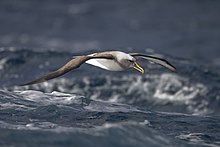
Back Stormvoëlagtiges Afrikaans نوئيات Arabic نوئيات ARZ Nankeydunol (Procellariiformes) AVK Fırtınaquşukimilər Azerbaijani Буравеснікападобныя Byelorussian Буревестникоподобни Bulgarian Procellariiformes Breton Procel·lariformes Catalan Procellariiformes CEB
| Procellariiformes Temporal range: Possible Late Cretaceous record
| |
|---|---|

| |
| Buller's albatross (Thalassarche bulleri) | |
| Scientific classification | |
| Domain: | Eukaryota |
| Kingdom: | Animalia |
| Phylum: | Chordata |
| Class: | Aves |
| Clade: | Austrodyptornithes |
| Order: | Procellariiformes Fürbringer, 1888 |
| Families | |
|
†Diomedeoididae | |
| Diversity | |
| 4 extant families, 26 genera, 147 species | |
Procellariiformes /prɒsɛˈlɛəri.ɪfɔːrmiːz/ is an order of seabirds that comprises four families: the albatrosses, the petrels and shearwaters, and two families of storm petrels. Formerly called Tubinares and still called tubenoses in English, procellariiforms are often referred to collectively as the petrels, a term that has been applied to all members of the order,[1] or more commonly all the families except the albatrosses.[2] They are almost exclusively pelagic (feeding in the open ocean), and have a cosmopolitan distribution across the world's oceans, with the highest diversity being around New Zealand.[3]
Procellariiforms are colonial, mostly nesting on remote, predator-free islands. The larger species nest on the surface, while most smaller species nest in natural cavities and burrows. They exhibit strong philopatry, returning to their natal colony to breed and returning to the same nesting site over many years. Procellariiforms are monogamous and form long-term pair bonds that are formed over several years and may last for the life of the pair. A single egg is laid per nesting attempt, and usually a single nesting attempt is made per year, although the larger albatrosses may only nest once every two years. Both parents participate in incubation and chick rearing. Incubation times are long compared to other birds, as are fledging periods. Once a chick has fledged there is no further parental care.
Procellariiforms have had a long relationship with humans. They have been important food sources for many people, and continue to be hunted as such in some parts of the world. The albatrosses in particular have been the subject of numerous cultural depictions. Procellariiforms include some of the most endangered bird taxa, with many species threatened with extinction due to introduced predators in their breeding colonies, marine pollution and the danger of fisheries by-catch. Scientists, conservationists, fishermen, and governments around the world are working to reduce the threats posed to them, and these efforts have led to the signing of the Agreement on the Conservation of Albatrosses and Petrels, a legally binding international treaty signed in 2001.
- ^ Warham, J. (1996). The Behaviour, Population, Biology and Physiology of the Petrels. London: Academic Press, ISBN 0-12-735415-8
- ^ Brooke, 2004.
- ^ Tennyson, Alan J. D. (2006). Extinct birds of New Zealand. Paul Martinson. Wellington, N.Z.: Te Papa Press. p. 38. ISBN 978-0-909010-21-8. OCLC 80016906.